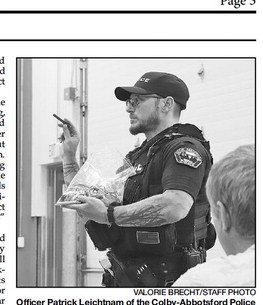Officials urge action to prevent youth access to THC products


By Valorie Brecht Health officials from the Clark County Health Department and local school officials are urging the Clark County Board of Supervisors to consider enacting an ordinance that would prohibit the sale of products containing hempderived cannabinoids to those under the age of 21.
Brittany Mews and Rebecca Greisen of the Clark County Health Department, along with Abbotsford School District Superintendent Ryan Bargender and Colby-Abby School Resource Officer Patrick Leichtnam, presented to the county board at its last monthly meeting to inform the board how youth in Clark County were gaining access to substances with psychoactive properties, and to urge the board to pass an ordinance to give the county legal footing to control the distribution of these substances.
“We are not prevention specialists, but we can agree that we don’t want our individuals or our youth to be using these substances,” said Mews. “If something’s not done on this issue, the youth will think it’s just normal. As a board, you have the duty to enact policy change.”
The following is an abbreviated version of their presentation.
Hemp, marijuana and the 2018 Farm Bill Hemp and marijuana plants are two varieties of the same plant species, cannabis sativa. There are over 400 naturally occurring chemical compounds between these two varieties of cannabis sativa plants. The major difference between hemp and marijuana is the psychoactive
Please see THC products, page 3 THC products,
from p. 1
component: Delta-9 tetrahydrocannabinol (THC). Marijuana plants contain more Delta-9 than hemp plants, while hemp plants contain both Delta-9 THC and Delta-8 THC. Legally, a hemp plant is a cannabis plant that contains 0.3% or less of Delta-9 THC. Without being altered, hemp plants do not possess enough THC for the high associated with marijuana.
To summarize the differences between the two, hemp is lower in the chemical that causes psychoactive properties (THC), while marijuana is higher in that chemical. Hemp can be made into textiles or clothing, or added to food. Marijuana is often consumed medicinally or recreationally. Hemp has a high cannabidiol (CBD) content, which is often used for pain relief and other medicinal uses, and is federally legal. In contrast, marijuana has a low CBD content and is federally illegal.
“Prior to 2018, hemp was not differentiated from marijuana. But the 2018 Farm Bill reclassified hemp, making it legal to grow, due to the plant containing under 0.3 percent THC,” Greisen explained.
This reclassification created a loophole, leading to the development of “novel THC” products. Manufacturers began extracting non-psychoactive cannabinoids (chemicals) from hemp, such as CBD, and converting it to Delta-8 THC, Delta-10 THC and others. Since novel THC products are not regulated, manufacturers can put whatever they want into them and do not have to put warnings or all the information on the labels. This includes Delta products commonly found in smoke/vape shops. This means that compounds that are derived from the hemp plant are unregulated and do not have age restrictions. Unless a retailer has its own restrictions in place, youth can legally purchase these products.
“Manufacturers do not have to put warnings on the label, although these compounds are not found naturally in the hemp plant,” said Greisen.
Youth are consuming these products in a variety of ways. Products can be ingested or smoked (joints, blunts, bongs, vape pens, etc.). They often have catchy logos, come in fruity flavors or as chocolate bars, or have packaging that resembles familiar candy (i.e. Sour Patch Kids, Peachie O’s, Fruit Gushers, etc.). Any product that has THC in it may appear on a drug test, even Delta products. A positive test could result in suspension from schools, clubs or sports.
According to the health department, THC (Delta) effects on youth include, in the short term: impaired judgment and attention, headaches, dry mouth and eyes, bloodshot eyes, dizziness or disorientation, lack of motivation, sleepiness, increased heart rate and appetite and nausea; in the long term: increased risk of stroke and heart disease, lung scarring, mood disorders, impaired thinking and poor memory which negatively impacts overall brain development, and strong associations between young users and developing mental health disorders and/or addiction; and in the case of over use or overdose: extreme anxiety or panic attacks, hallucinations, fast heart rate or chest pain, uncontrollable shaking or seizures, pale skin or unresponsiveness. There are also concerns of teen drivers driving while “high.”
Local presence of novel THC products In July and August of last year, the health department conducted four site visits in the county to two bar and grills and two smoke shops. At the first bar and grill, there was signage behind the counter advertising the availability of the Delta product, but when asked, the bartender said they no longer carried the product. In the other bar and grill, there was no signage, but they had the Delta product available behind the counter.
The first smoke shop had signage on the outside of the building saying only ages 18-plus could enter the building, but no one checked IDs at the door. However, the clerk said they only sell Delta products to ages 18-plus. The owner said they scan IDs of anyone who looks to be under 40, but this did not happen when the clerk completed a transaction. Several Delta-8 products were available, with many having packaging similar to familiar candies or chocolates. The first location also had a chart listing different cannabinoids such as Delta-8, Delta-11, and THCA (tetrahydrocannabinolic acid) and the corresponding “high” users can expect to experience, such as from “low,” “medium,” “high,” “extremely high” or “space cadet.”
The second smoke shop the health department visited had signage on the outside of the building stating they only sell tobacco to ages 21-plus. The owner stated they only sell Delta products to ages 21-plus, with them physically checking IDs, as there is no scanning system. All Delta products were either behind the counter, in a locked display case or in the refrigerator. Very few products had packaging similar to candy or chocolate.
Mews said she also had an experience in a neighboring county in which she and a friend were at a bar and they each asked for a soda. Her friend got a “social seltzer” which contained about 10mg of hemp extract, including 2.5mg of THC, enough to get a “light and buzzy experience” according to the can’s label. The bartender did not inform the friend that the drink was psychoactive or contained THC. Mews said this experience showed that these products are present all over and it may not be obvious that it’s a THC product.
Impact of novel THC products in schools Leichtnam said that Marshfield Clinic Health System received an opioid treatment grant for more than $9 million, and he had sat on the grant committee for the last six years.
“That’s kind of what spearheaded this whole talk of, Delta products, THC products, vaping in general and our youth… I don’t know why, but use of these products has exploded in these last six years. It’s everywhere.”
He said that often packages for edibles would promote Delta-8 on the front, but if you flip the package around, on the back it would list there is also 75% or 80% THC present in the product.
“It’s very accessible to our kids. They can buy it on the internet. They can walk right into the stores and buy it themselves if they’re not IDed or carded,” he said.
He said that even if stores follow age restrictions, youth had parents, older friends or relatives buying the product for them and it was making its way into our schools. Around four to five years ago, Bargender had vape detectors installed in the Abbotsford School District “and we’ve been working the problem ever since then,” said Leichtnam.
“What we’re telling you about our school and being transparent about this, it’s not just a problem at Abbotsford or Colby schools; it’s a problem at all our schools. You’re just not hearing about it from those schools,” he said.
“I’ll go to superintendent conferences both regionally and locally here, and they’re all talking about the same thing,” Bargender added.
Bargender said that over the last “several years,” Abbotsford had five students who were expelled because they could not stop vaping. Several more are on pre-expulsion agreements.
Leichtnam said he had driven students to counseling appointments, and some truly wanted to get help and not be addicted. But some hadn’t hit that “rock bottom” point yet where they were ready to seek help.
Every middle school and high school bathroom in the Abbotsford School District now has vape detectors. Leichtnam said even if students know detectors are there, they may still try vaping in the bathroom. The detectors detect anything that is not ambient air, whether it’s THC from a vape or smoke from a cigarette, and send a notification to Leichtnam and the superintendent. If they’re not busy at the time, they will go the bathroom; otherwise they will look at school camera footage to see who came out of the bathroom after the notification. They will then interview those students and ask them to empty their pockets, etc.
“Once you start searching kids, you start finding that
Please see THC products, page 8
VALORIE BRECHT/STAFF PHOTO THC products,
from p. 3
they were vaping,” said Leichtnam.
A lot of the devices students use to vape look like pens, flash drives, or even smart watches. The device can be charged by plugging it into your computer or cell phone. The device heats the liquid to a vapor and that’s how students vape.
Leichtnam also said he had found empty packages of THC edibles that looked just like the packages for Reese’s chocolates and Fruit Gushers. The “high” students who had eaten the products were sent home and one was arrested for giving it to the other one.
In the first two months of this school year, Leichtnam confiscated 18 vaping devices from students. Fifteen of those were for THC products. Leichtnam said students typically aren’t smoking nicotine, but rather THC.
“The kids will have their own flavors that they like in these little pods or carts (cartridges), and they’ll share the electronic device that goes with it in the toilet paper roll in the bathroom or somewhere. Yes, we’ve found them in nasty places. But it’s very easy for students to hide this (the cartridge) somewhere on their person — their toes, their underwear, their bra, whatever,” said Leichtnam.
He gave an example of a vape pen that, brand new, would cost about $25. He said that companies were competing for how many inhalations they could get their product to max out on, perhaps 1,000 puffs or 4,000 puffs.
Leichtnam said it was definitely possible to overdose on THC and easier to do so while vaping than smoking a joint, because vaping delivers a much higher concentration of THC than if you were to just smoke the plant.
“We had one kid at school; he was so high — we didn’t find a device on him, but he was so high that he was in the conference room next to the principal’s office, crawling around on the table barking like a dog,” said Leichtnam.
He also said that retailers were finding creative ways to market and sell these products. For example, THCA is a naturally occurring cannabinoid that is abundant in raw cannabis buds that does not becomes psychoactive until heated, smoked or vaped.
“I’m not a chemist; I don’t know exactly how they do some of these things, but they take that THC from that marijuana or that hemp, and you liquid-nitrogen freeze it, and it loses one part, so it’s no longer illegal. It’s legal now. That’s literally what THCA is — nitrogen frozen marijuana. And so they put it on the box: ‘Do not smoke or burn’ because once you heat it, it becomes THC and now it’s illegal. So they’re finding loopholes to make this stuff, to relabel it, to get it on the shelf and into kids’ hands,” said Leichtnam.
Government response The issue came up with the Abbotsford City Council recently, as All New Tobacco Vape Outlet LLC was requesting a cigarette, tobacco and electronic vaping device retail license to open a store in Abbotsford. The proposed store location was on First Street across from an arcade and Leichtnam had concerns about it targeting youth. The company seeking to open a store was the same one that opened a store in Medford at the old Yamaha dealer on Highway 13.
“I found out that they are a chain store in about 16 different cities. I called up the police departments for four of those cities and all four of them had had problems with the shops in their town selling to underage (people). None of them have been able to make arrests — well, one city, Waupaca made some arrests for selling to underage there. But they all complained about it. Medford’s complained and they’re trying to investigate them,” Leichtnam said.
Leichtnam also visited the Medford store and estimated it sold about 80% THC products, including a lot of gummies and other edibles, and about 15% nicotine products. He brought back his findings to the Abbotsford City Council. They decided not to issue the permit and also passed an ordinance last month prohibiting the possession or use of hemp-derived cannabinoid products by anyone under the age of 21, as well as prohibiting the selling of those products to those under 21.
The ordinance specifies that it is referring to intoxicating cannabinoids and spells out which cannabinoids are prohibited. This will ensure that the existing smoke shops in Abbotsford cannot sell to those under 21. Another Abbotsford ordinance also prohibits the sale of vaping products within 1,500 feet of a medical clinic, parochial school, city park, city playground or municipal buildings.
Two years ago, Wood County also unanimously passed an ordinance very similar to the Abbotsford one. The Wood County ordinance prohibits the sale of hemp-derived cannabinoids to those under age 21. Both ordinances have a photo ID requirement before a person can purchase a hemp-derived cannabinoid product. The Wood County ordinance also specifies that the hemp-derived cannabinoids cannot be sold within 750 feet of a hospital, church or youth-serving organization such as a childcare center, school, playground, afterschool club, etc. The City of Medford has passed a similar ordinance.
Mews said it was important for local municipalities to act on this issue and take steps to protect local youth on their own, because there likely would be no action on the state or federal level anytime soon.
“Last week, Rebecca (Greisen) and I actually met with Sen. Tammy Baldwin’s senior advisor to educate – not to lobby, just to educate and say this is what we’re seeing – and when I asked if there was any projection of anything happening on the federal level, she said she’d be shocked if anything happened within a year,” Mews said.
Mews also said that Wisconsin Rapids was the only municipality that hadn’t adopted the Wood County ordinance. However, the county had 100% compliance at retail checks, including when underage university students attempted to purchase these products. Medford County has also educated the public, provided signage indicating the age requirement and offered ID scanners for purchases.
“Is our county willing to hop on board and follow the lead of another county and maybe do the same thing here?” asked Leichtnam.
Potential next steps for Clark County Any proposed ordinance would have to go through the Board of Health first before being brought to the entire county board. Mews said part of the purpose of the presentation was to inform the county board and also gauge the county board’s level of support so the Board of Health knew if it should move forward with drafting an ordinance or not.
A few county board members had follow-up questions or comments. Board member Scott Jalling wanted to know: if the county passed an ordinance, what would happen to the Abbotsford ordinance?
“Municipalities would have to adopt the county’s ordinance or create their own,” Mews replied.
County board member Scott Johnson wanted to know how effective it was to pass an ordinance if kids could still readily access these products online.
“Yeah, kids that want it will get it. But if it’s readily available in our stores, it seems more normal. So hopefully an ordinance would curtail use,” said Mews.
County board member Leonard Stoecker made the comment that novel THC products seemed to him to be more dangerous than marijuana, because of a higher potency. He also said the county couldn’t wait for higher levels of government to take action to address the problem.
“I would not look to the feds or states to touch this issue anytime soon. I think the thing is, we need to look at protecting our youth,” he said.
County board member Ashley Thielman said she recalled back in 2018 or 2019 when the company Juul was in the news for marketing its products to children. She said novel THC products were potentially even more harmful.
“This stuff is not regulated. It looks like the candy just like my kids like,” said Thielman.
The Clark County Board of Health plans to discuss the issue at its July 11 meeting and determine next steps, including possibly drafting an ordinance to present to the full county board.
“They (retailers) are finding loopholes to make this stuff (novel THC products), to relabel it, to get it on the shelf and into kids’ hands.”
-- Colby-Abbotsford School
Resource Officer Patrick
Leichtnam



